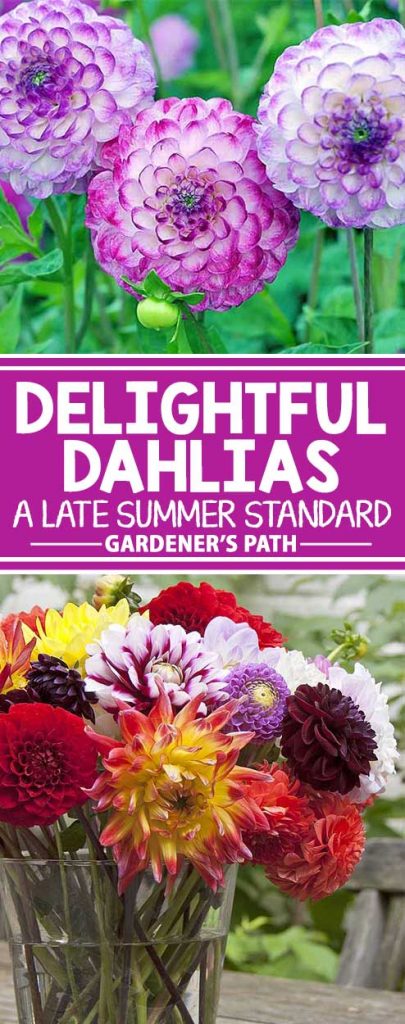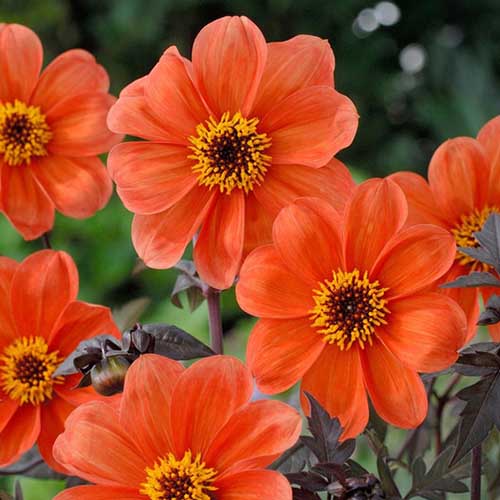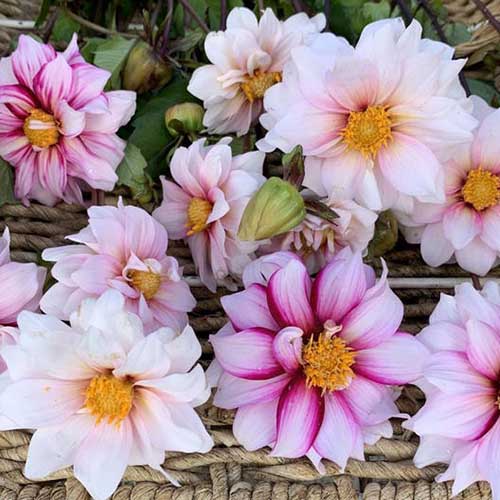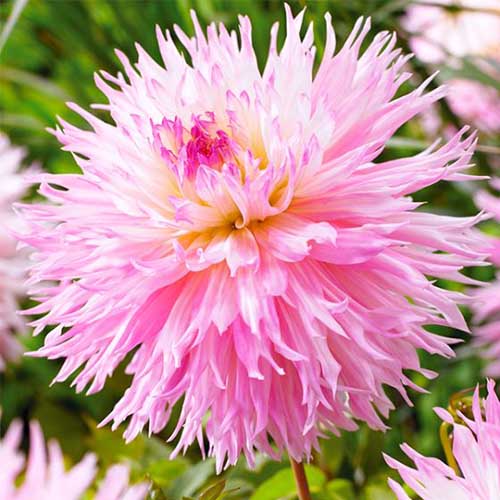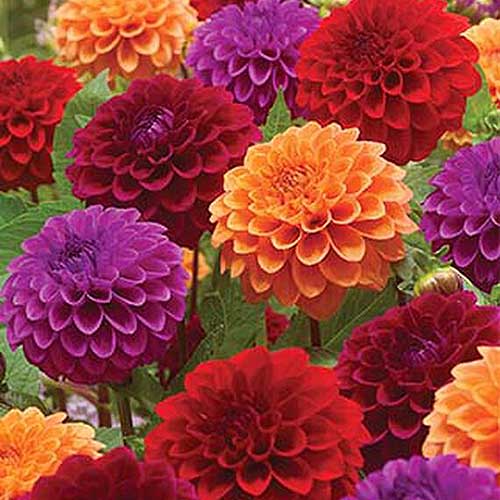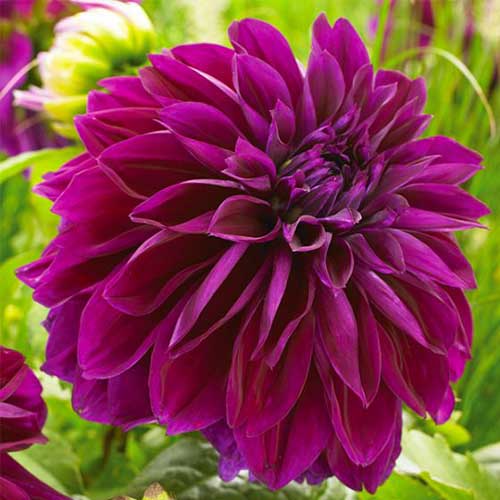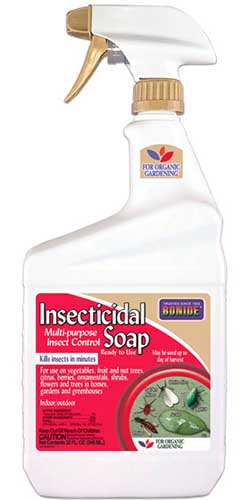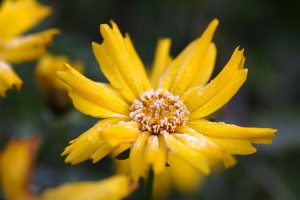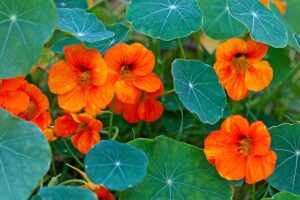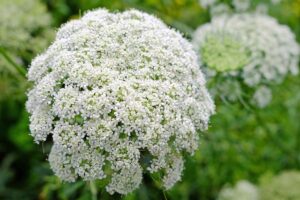Dahlia spp.
When the late season garden starts to fade from summer’s heat, dahlias are one of the best choices to add delightful months-long displays of brilliantly colored blooms.
The timing of these flowers is perfect!
From July until the arrival of frosty temperatures, these bold blossoms give a fresh look to tired beds, containers, and window boxes.
Dahlias are fast growing, and easy to cultivate and multiply as well. Tender perennial tubers, they’re most often grown as annuals – the tubers may be lifted and stored in fall, then divided and replanted the next spring.
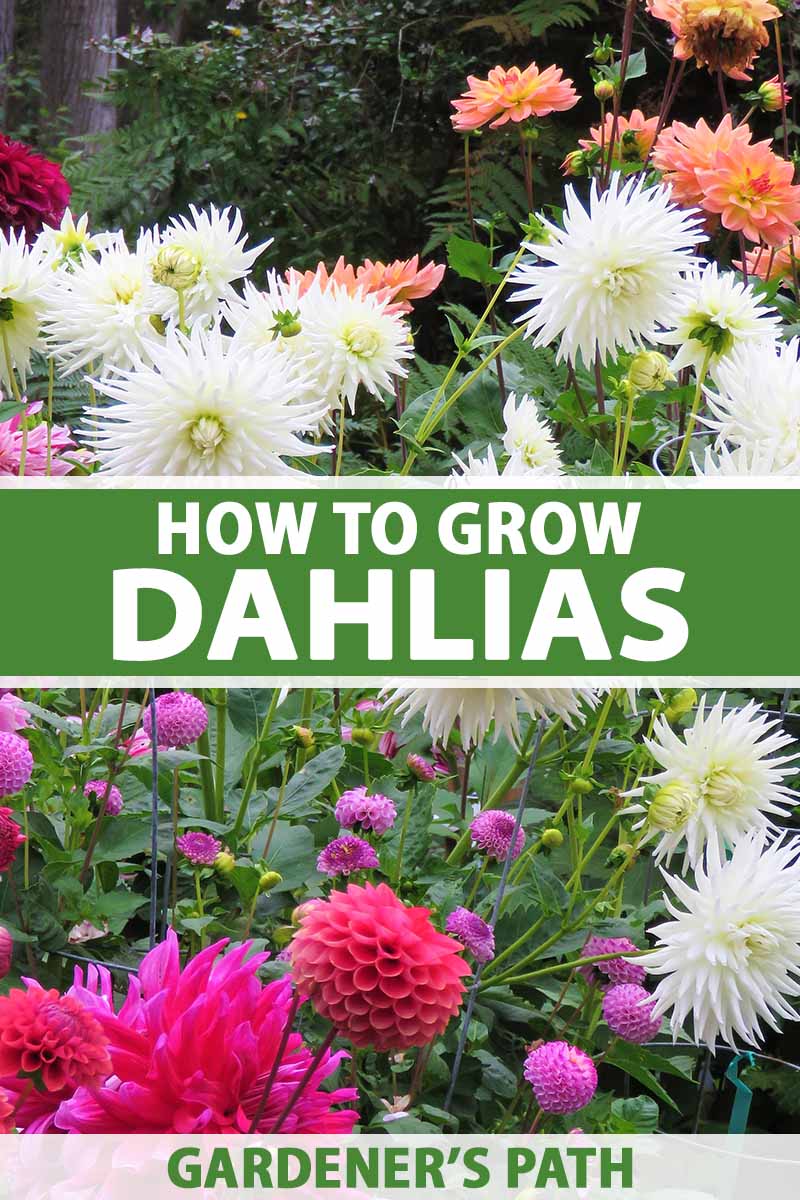
We link to vendors to help you find relevant products. If you buy from one of our links, we may earn a commission.
And they make gorgeous cut flowers as well, with many folks growing them for the sole purpose of cutting. The bright, showy booms have fantastic forms and fascinating geometry, adding long-lasting allure to floral arrangements.
Highly versatile, there are thousands of cultivars available in a wide array of colors (everything but true blue), flower forms, and sizes.
From dwarf varieties with petite flowers to towering giants with huge dinner-plate-sized blooms, there’s at least one dahlia suitable for just about every garden!
Join us now for a look at how to plant dahlias for delightful late season color.
Here’s what’s ahead:
What You’ll Learn
What Are Dahlias?
Dahlia is a genus of herbaceous perennials, tubers grown often as annual flowers in many regions for their brightly colored blooms in the late season garden.
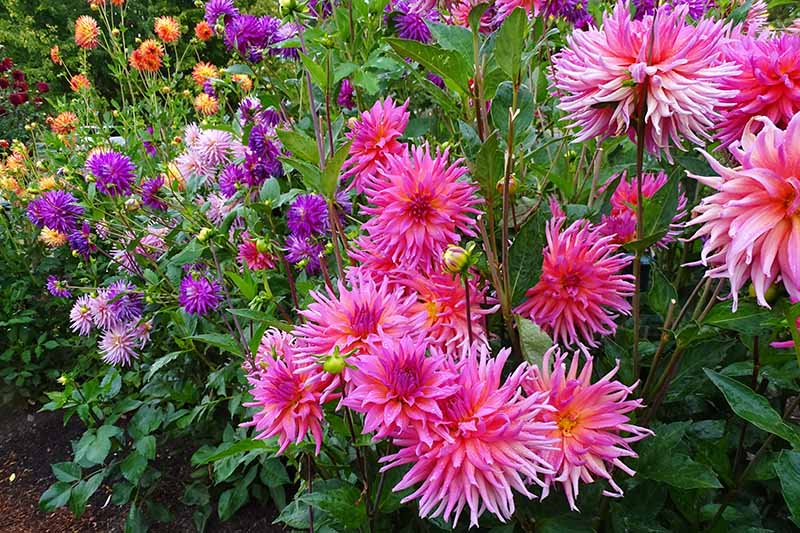
Tubers are the plants’ energy storage depots. They grow large and plump over the growing season to supply the fuel needed to survive lean winters.
Native to mountainous regions of Mexico and Central America, this member of the Asteraceae family is noted for its brilliant, star-shaped flowers.
The name Aster, the largest genus in the family, comes from the old Greek for “star,” and close family relations include asters, chrysanthemums, daisies, marigolds, sunflowers, and zinnias.
Their pinwheel blossoms and eye-catching colors come at a time when many plants are lagging and past their best. With a long season, dahlias bloom from July right into autumn, flowering until they are killed off by frost.
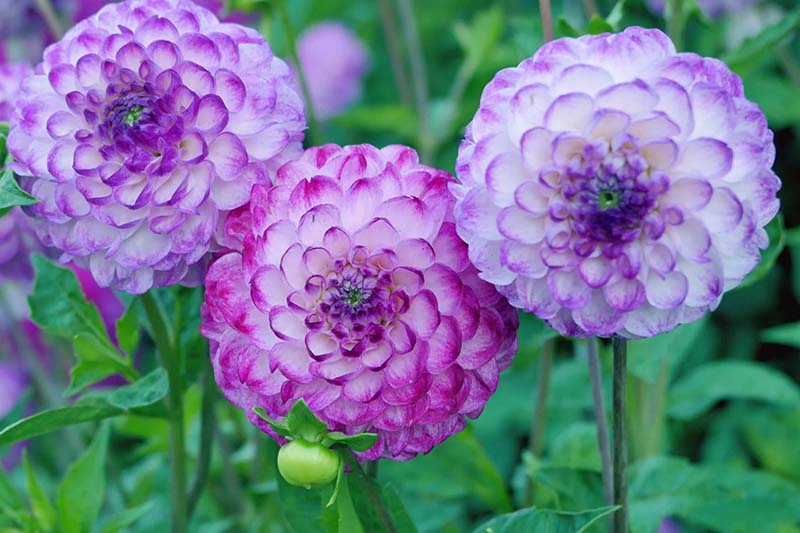
The national flower of Mexico, they like warm daytime temperatures of 70 to 80°F and cool evenings around 65°F. In excessive heat and humidity, they tend to wilt and are prone to powdery mildew.
However, there are now plenty of disease-resistant cultivars that do well in these conditions – ‘Akita,’ ‘Lavender Perfection,’ and ‘Tartan’ are just a few.
Flower sizes can be small, like the two-inch patio varieties, while larger types with blooms the size of dinner plates can have flowers as big as 14 inches across. And cutting these flowers encourages them to produce more.
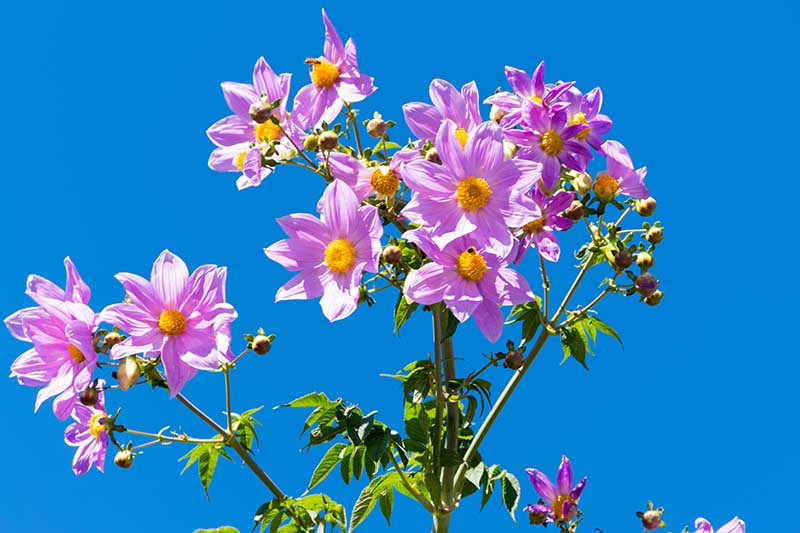
Plant heights are equally diverse, ranging from dwarf varieties of 12 inches to the towering bell tree dahlia, D. imperialis, which can grow to 25 feet!
Dahlias have no scent and attract pollinators like bees with their vibrant displays of bright colors.
The tender tubers are hardy only in Zones 8-11, so in areas with moderate to cold winters they need to be dug up and stored before freezing temperatures arrive.
With over 40 species and 50,000 registered cultivars worldwide, the selection is mind-boggling. But not to worry, identification is made easier with three group classifications.
Learn more about the different types of dahlias and their classification.
Cultivation and History
Dahlias were first cultivated by the Aztec people, who grew the tubers for eating like potatoes, and for medicinal purposes. Large flowers and the hollow stems of tree dahlias were also used to collect and carry precious water.
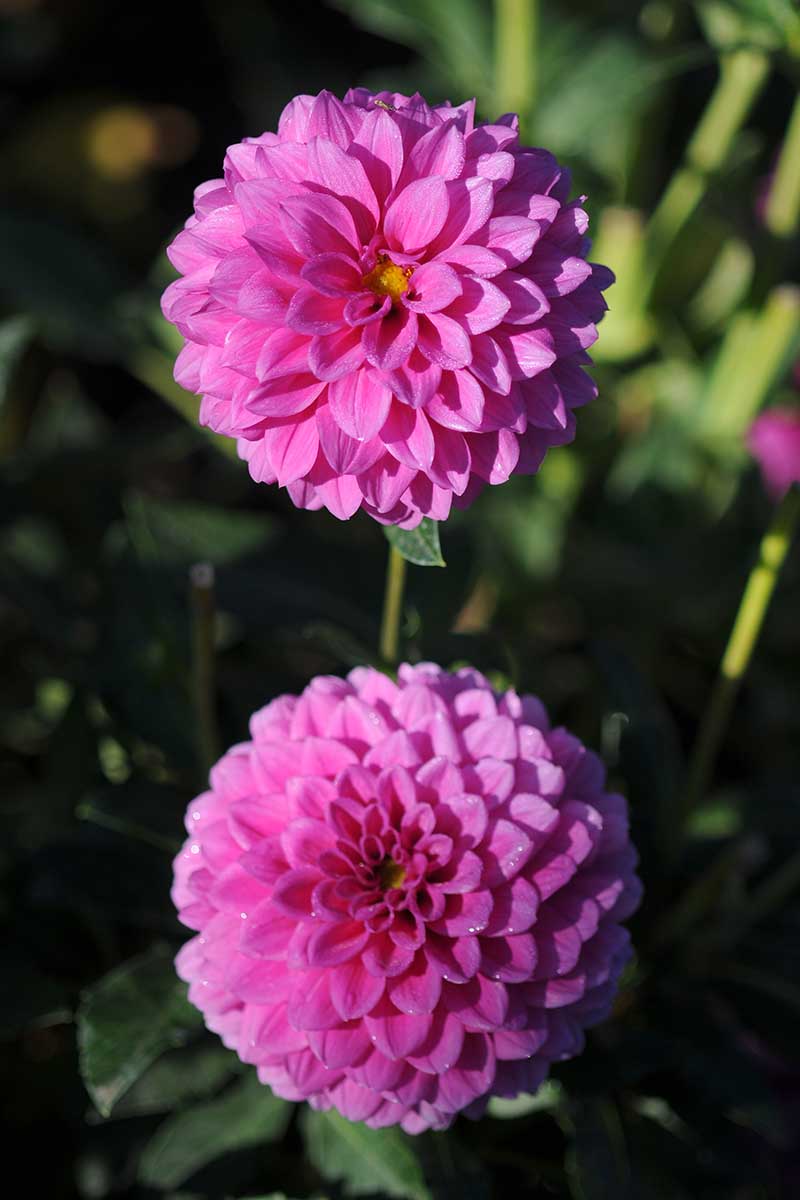
They were first chronicled under the name acocotli (water pipe flower) by Spanish botanist Francisco Hernandez in 1570.
They made their European debut at the Botanical Gardens in Madrid in the late 1700s when another Spaniard, Antonio Jose Cavinilles, grew plants from the seed of three wild varieties. It was also Cavinilles who named them for the renowned Swedish botanist and environmentalist, Andreas Dahl.
The seeds of these three varieties were shared with plant enthusiasts from England, France, Germany, and Italy, and by the early 1800s breeding was underway in earnest.
In the early part of the 19th century the first double cultivar was introduced, classifications were issued for introduced cultivars, and several new species were discovered in Mesoamerica as well.
It’s unclear which plants were initially grown in North America, but the first American Dahlia Society was organized in San Francisco in 1915 – a sure sign of their growing popularity with the home gardener.
Propagation
Dahlias can be propagated by cuttings, tuber division, or seed. However, growing plants from seed is an unreliable method.
Most of the stock available for home gardens comes from hybrid cultivars, which may produce offspring untrue to the parents.
That is, they often don’t have the same favorable qualities such as color, disease resistance, flower count, and flower forms.
Cuttings
Cuttings are clones of the mother plant, so they always produce the same qualities.
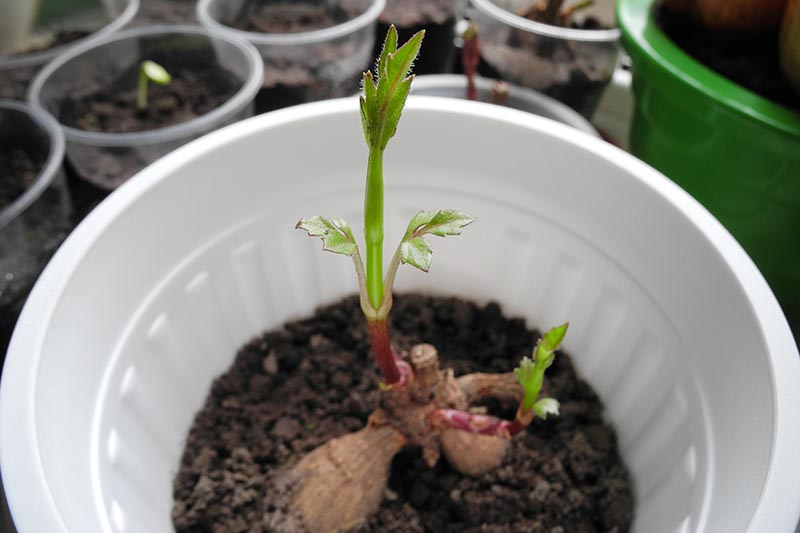
Sprout cuttings can produce up to six new plants from a single tuber, but they require a controlled environment of consistent humidity, warm temperatures, and day length.
Dahlias are photosensitive, and to develop healthy feeder roots as well as tubers, they require a day length of 12 hours or greater. If needed, add a grow light to your setup to meet this rooting requirement.
In late winter or early spring, choose a selection of healthy, firm tubers from your storage bin.
Add four to six inches of moist potting soil to a tray – or create your own soil blend of one half aged compost and one half landscape sand.
Nestle tubers into the soil, covering the bottom two-thirds, but keeping the neck and crown above the soil.
Place the tray in a 65 to 75°F location where it can receive bright indirect light.
Keep the soil moist but not wet, and within three to four weeks, sprouts will emerge from the tubers.
Once the sprouts are three inches or taller, use a clean, sharp knife to carefully cut each sprout away, taking a small notch of tuber with it.
Remove the bottom set of leaves and dip the lower one to two inches of stem into a rooting compound, then gently shake off the excess.
Fill small, four- to six-inch pots with moist potting soil.
Make holes and insert three stems into each pot, one to two inches deep, and gently firm the soil around each stem.
Place in a 65 to 75°F location that receives bright, indirect light for at least 12 hours each day. Roots form in two to three weeks.
Maintain even moisture in the potting medium, but do not allow it to become waterlogged.
Eight to 10 weeks later, sprout cuttings can be transplanted to larger pots, or planted into the garden when soil temperatures warm to 55 to 60°F. Plant to the same depth as they were growing in their starter pots.
Plants will flower in their first year, and healthy new tubers will form over the growing season.
Tuber Division
Tuber division is a much simpler propagation method. And divisions also produce clone offspring with the same characteristics as the mother plant.
For successful propagation, it’s important that each division has a section of crown with a healthy neck and piece of tuber attached.
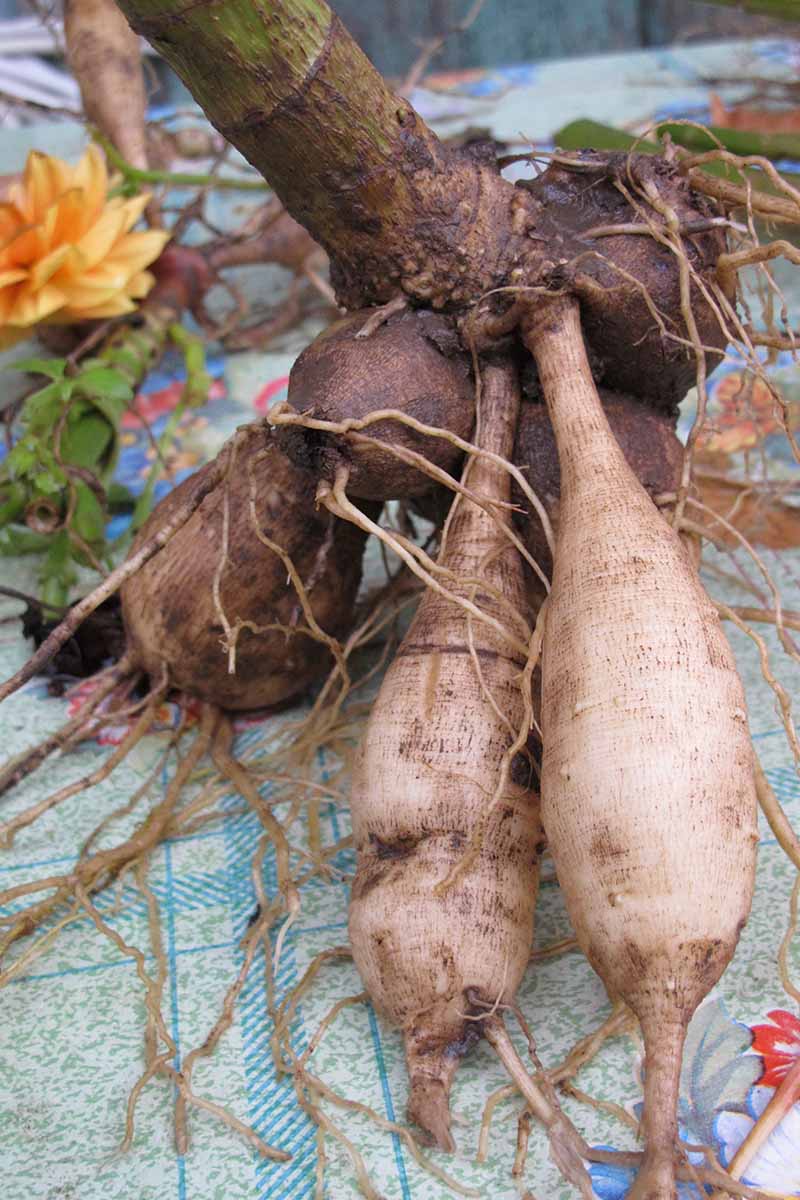
When all danger of frost has passed, remove tubers from storage and gently brush away any storage material.
Use a clean, sharp garden knife or shears to carefully dissect the crown.
First cut the crown in half, then cut again equally into quarters or thirds; aim to have a piece of crown at least the size of a marble for each new division.
A visible “eye” (where new growth emerges) isn’t necessary, provided each new section has a portion of the crown with an intact neck and healthy tuber attached.
To prevent bacterial or fungal infection, dust the cut surfaces of each section with a fungicide such as garden sulfur.
Allow the divisions to air dry for 24 to 36 hours before planting out into containers or the garden.
Get more details on dividing dahlias or learn how to propagate them via stem cuttings.
How to Grow
Tender perennials, dahlias are hardy only in Zones 8-11.
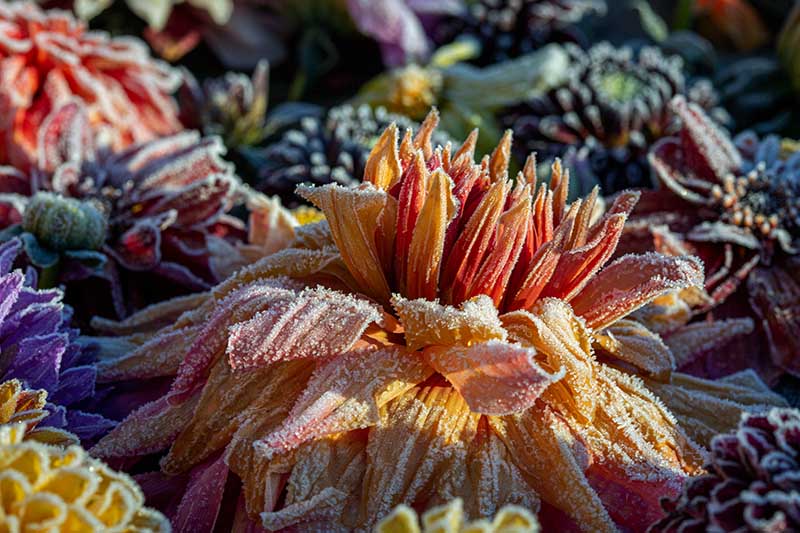
Typically grown as annuals, tubers are lifted in autumn, stored over winter, then planted again in spring when soil temperatures have warmed to 55 to 60°F, or at about the same time when corn, tomatoes, and potatoes are planted.
They need a location that receives six to eight hours of sunlight each day, preferably with some afternoon shade, in well-draining, humus-rich soil with a pH of 6.6 to 7.0.
Dahlia tubers enjoy a mounded planting site of rows or domes four to six inches tall and wide.
Mounding provides warmer soil and improves drainage. Plus, the loose, friable soil makes it easier for the new tubers to grow. And mounds also make lifting tubers in fall quicker and easier.
Here’s how to plant:
At your planting site, amend the soil with a shovelful or two of organic matter such as aged compost or well-rotted manure.
Add in a shovelful of landscape sand or pea gravel to improve drainage if needed.
Mix in bone meal for strong root development.
Mound the soil into rows or domes four to six inches tall and wide.
Plant tubers so the crown of each is under two inches of soil, eyes pointed up. If no eyes are evident, plant with tubers on the bottom and the crown on top.
Gently firm the soil in place. Avoid watering at the time of planting unless conditions are very dry – overly wet conditions can cause tubers to rot, and regular springtime precipitation should be adequate.
Wait until the first leaves break through the soil before watering, then give them a good, deep soak one to three times per week as needed.
Allow the top inch of soil to dry out between watering, but for consistent growth, ensure the roots stay moist. You can find out more about how to water dahlias in our guide.
Add a two to three-inch layer of leaf or straw mulch for moisture retention if needed.
Dahlias are fairly heavy feeders, and a low-nitrogen fertilizer of 5-10-10 (NPK) can be applied one month after planting, and once or twice more at 30-day intervals.
Avoid over-fertilizing, as too much will promote robust leaf growth with a low blossom count.
Small to medium-sized flowers take approximately 90 days to bloom, while the larger ones can take as long as 120 days.
Growing Tips
Keep the following tips in mind for the best display of flowers:
- As plants grow, trim away the lower 8-12 inches of foliage to help prevent the appearance of unwanted pathogens such as powdery mildew.
- Provide a break from extreme heat with afternoon shade.
- Pick flowers frequently to encourage more blooms.
- To maintain an abundant supply of flowers, tubers should be dug up each fall, stored for winter, then divided and replanted the following spring – even those in areas with mild winters.
- Don’t lift tubers too early in fall – as long as the ground doesn’t freeze, keep them in soil until mid-autumn to ensure their full growth.
Pruning and Maintenance
To promote a compact shape with more flowers, pinch out the main stem early in the growing season. Pinch the larger-flowered varieties just above the third set of full leaves.
For small-flowered varieties, allow plants to reach 12 to 18 inches high, then pinch above the fourth or fifth full set of leaves.
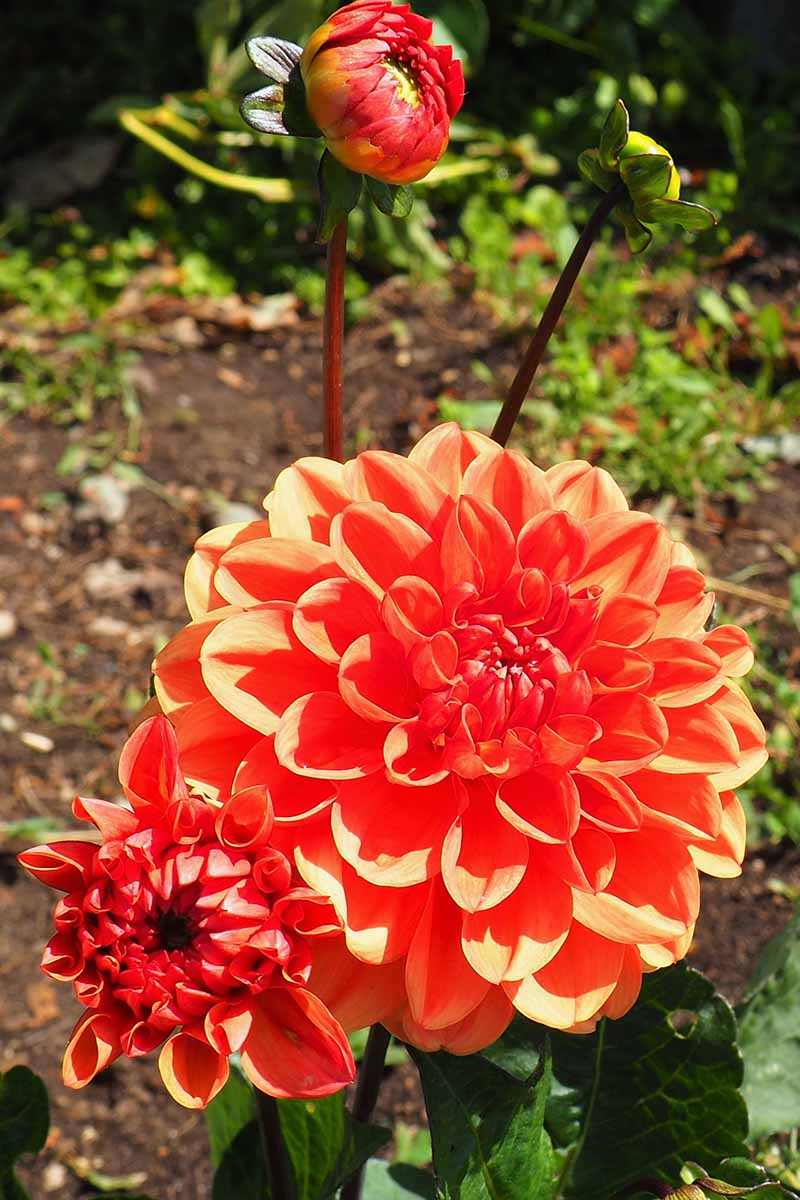
Plants with large flowers can become top heavy and may require staking. We provide staking and support tips here.
In autumn after a hard frost, lift, clean, and store tubers for winter. Or lift by mid-November if you don’t get frosty temperatures.
Tubers can overwinter in the ground in areas with mild winters, but flowering is much more abundant when they’re lifted and divided annually. For more details on this step, read our article on how to lift dahlias for winter storage.
Left in the ground, tubers can form a massive clump, producing more and more stems with progressively smaller and fewer flowers – until the clump eventually stops growing.
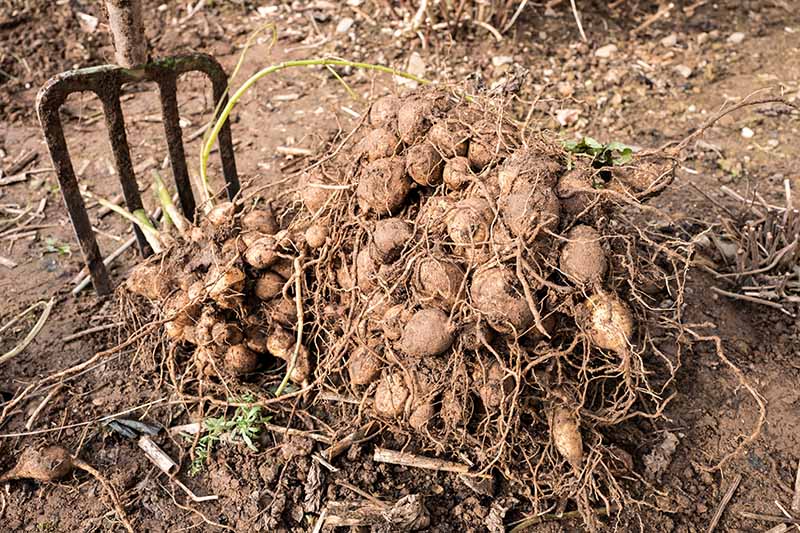
However, the annual lifting and division of tubers keeps plants strong and healthy, produces more flowers, and makes it easy to propagate new plants.
To lift tubers, wait a couple of weeks after the first frost when the foliage has died back. Or, if you don’t experience freezing temperatures, dig them up by mid-November.
Cut the stems back to four to six inches, then loosen and lift the tubers with a fork or spade. Shake or brush off excess soil and allow to air dry for a few days in a dry spot with above-freezing temperatures.
Place the clump in a bin or cardboard box, layering the tubers with materials such as slightly moist sand, peat moss, or vermiculite. Store the bin in a cool, dark, and dry spot – ideal storage temperatures are 40 to 50°F.
If you choose to leave the tubers in the ground over winter, cut the stalks down and provide a thick layer of dry mulch for root protection.
Dig and divide tubers in spring, allow them to dry for a few days, then plant when all danger of frost has passed.
Cultivars to Select
There are 42 species and over 57,000 dahlia cultivars, with D. coccinea the parent of all hybridized plants.
Award winning cultivars include ‘Bishop of Llandaff’, ‘Clair de Lune’, ‘David Howard’, ‘Fascination’, ‘Gallery Art Deco’, ‘Honka’, ‘Moonfire’, and ‘Twyning’s After Eight.’
Here are a few favorites from the many available cultivars:
Bishop of Oxford
‘Bishop of Oxford’ is a peony-flowered variety with divine four-inch flowers of coral orange that are beautifully set off by the gorgeous purply-black foliage.
Plants grow up to 36 inches and make an excellent addition to beds, borders, containers, and patio pots or butterfly, cottage, and cutting gardens.
Cultivate in groups of five or more for a striking display from July until frost.
Tubers are available at Eden Brothers.
Edge of Joy
A joyous addition to any garden, ‘Edge of Joy’ flowers are three-inch, single to semi-double anemone types. They feature a fringed golden center surrounded by lovely white petals that are boldly streaked in magenta.
The foliage is medium green and plants grow up to 24 inches, flowering from July to November. Suitable for beds, borders, containers, patio pots, windowboxes, and butterfly gardens.
You can find tubers available from Eden Brothers.
Nadia Ruth
A laciniated variety, the split and twisted petal tips of ‘Nadia Ruth’ give a delicate, fringed appearance to the sparkling, six to eight-inch bubblegum pink flowers.
Foliage is light to mid-green and plants reach a mature height of 36 to 48 inches. Outstanding for late season interest in beds, borders, and foundations, or butterfly, cottage, and cutting gardens.
Tubers are available at Nature Hills Nursery.
Summer Tango Collection
A mixture of ball flowers, the Summer Tango collection adds fiery heat to the garden with four-inch globes in glorious shades of burgundy, peachy orange, and purple while the mid-green foliage adds a cooler base.
Plants grow up to 40 inches and are superb as cut flowers or in mixed perennial beds, foundations, and butterfly or cottage gardens.
Tubers are available at Burpee.
Thomas Edison
A decorative dahlia to the max, ‘Thomas Edison’ has magnificent, double petaled, eight-inch flowers of rich, deep purple that glow above the medium green foliage. The broad, blunt petal tips fade as they age, giving a pleasing ombre appearance.
Plants grow 36 to 48 inches tall and make a striking statement in foundations and mixed beds, or butterfly, cottage, and cutting gardens.
To really make the purple pop, try underplanting with flowers in shades of orange or red – like ‘Bishop of Oxford.’
Tubers are available at Nature Hills Nursery.
Managing Pests and Disease
Dahlias are resistant to deer and squirrels, but slugs and snails enjoy munching on tender new growth when young leaves and stems emerge from the soil.
Hand pick and dispose of slugs and snails, or control their access with a barrier of diatomaceous earth.
If these slimy gastropods are problematic for you, be sure to read our article on the best natural methods to protect your garden from slugs and snails.
Caterpillars like to chew on the foliage as well, and can also be controlled by hand picking.
Other pests include sap suckers such as aphids, mites, and thrips.
These pests can weaken plants, spread viruses such as necrotic spot, and cause black spots on leaves and buds, yellowing leaves, and distorted or stunted growth.
Control sap suckers with the addition of beneficial insects such as ladybugs and lacewings. Or a strong blast of water from the garden hose is effective as well – be sure to spray the top of leaves, undersides, and stems.
For persistent infestations, an application of a residue-free insecticidal soap may be necessary.
Bonide Insecticidal Soap is recommended for organic gardens and is available at Arbico Organics.
Read our full guide to identifying and controlling dahlia pests here.
Common diseases include gray mold or Botrytis blight, caused by Botrytis cinerea, and powdery mildew, caused by Golovinomyces cichoracearum.
Gray mold appears as a fuzzy, light gray growth after extended periods of drizzle or rain, or in high humidity. It first causes a brown discoloration, then wilting of buds, flowers, leaves, and stems.
Powdery mildew is a gray-to-white dusting on the leaves and stems that causes wilting and collapse. It grows in high humidity and cool, damp conditions.
Treat these diseases by removing and destroying damaged parts. Avoid overhead watering that can splash pathogens onto lower leaves. Plant in full sun, and ensure adequate air circulation and drainage.
Learn more about dealing with powdery mildew in dahlias in our guide.
Less common diseases include the following:
Dahlia mosaic virus is caused by a pathogen in the Caulimovirus genus, spread by aphids transferring infected sap from plant to plant.
It causes disfiguration and yellowing of leaves, stunted growth, and overall poor health. Remove and destroy infected plants and control aphids to prevent its spread.
Stem rot causes stems to turn soft and rot, and is the result of wet, soggy soil. Ensure tubers are planted in well-draining soil to avoid it.
Verticillium wilt is caused by Verticillium fungi that live in the soil. It causes leaves to curl and discolor to dark brown or black, and stems to wilt.
Once a plant is infected, it must be removed and destroyed. Avoid sowing susceptible cultivars in the same soil.
Best Uses
Dahlias are wonderfully versatile in the garden.
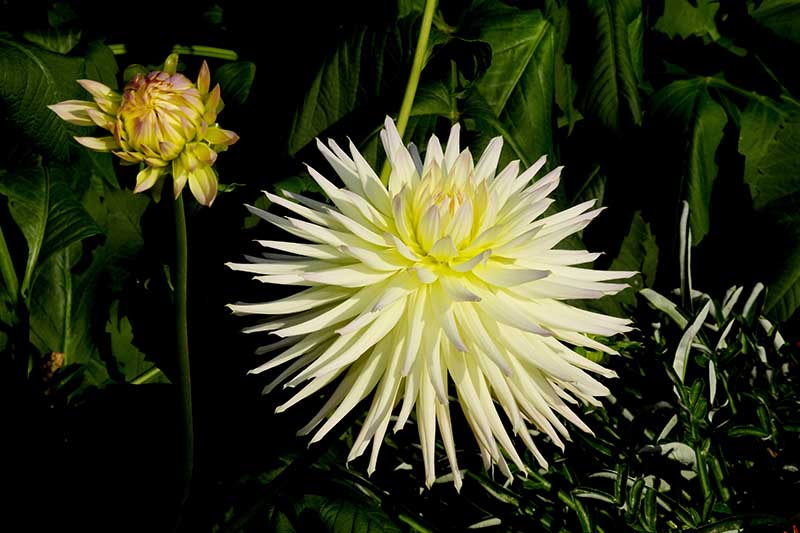
Taller varieties add attractive interest to the rear or center of beds, and mix well with other late flowering perennials and ornamental grasses.
Shorter varieties are better suited for the front of beds or used as a low border. Mix with annuals and other low to mid-size perennials for an eye-catching display.
Dwarf varieties add excellent color to borders, containers, patio pots, and window boxes.
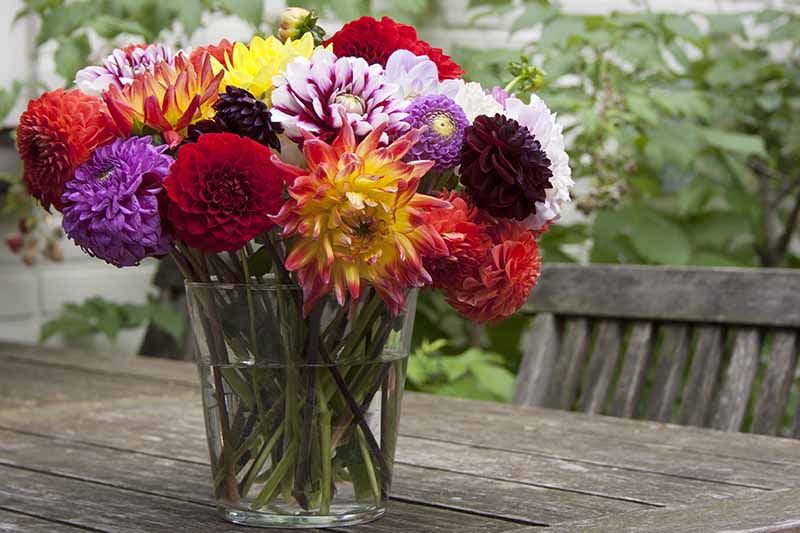
And all varieties make a welcome addition to butterfly, cutting, and cottage gardens.
For floral arrangements, cut 12-inch stems and remove the two side buds.
Quick Reference Growing Guide
| Plant Type: | Tuberous flowering bulb | Flower / Foliage Color: | Bicolors, black, bronze, lavender, orange, pink, purple, red, variegated, white, and yellow; mid-green to dark bronze/purply black |
| Native to: | Mexico, Guatemala, and other regions of Central America | Maintenance: | Low |
| Hardiness (USDA Zone): | 8-11 | Tolerance: | Deer, squirrels |
| Bloom Time: | July-November | Soil Type: | Loose, humus-rich |
| Exposure: | Full sun | Soil pH: | 6.5-7.0 |
| Time to Maturity: | Up to 90 days (small/medium flowers), up to 120 days (large/extra large) | Soil Drainage: | Well-draining |
| Spacing: | 9-18 inches | Attracts: | Bees, butterflies, hummingbirds, other pollinators |
| Planting Depth: | 2 inches (crown) | Companion Planting: | Agapanthus, aster, chrysanthemum, cranesbill, globe thistle echinacea, sea holly (Eryngos), sneezeweed (Helenium), and stonecrop (Sedum) |
| Height: | 9-60 inches, depending on cultivar | Uses: | Beds, borders, containers, foundations; butterfly, cottage, and cutting gardens |
| Spread: | 12-24 inches | Family: | Asteraceae |
| Growth Rate: | Fast | Genus: | Dahlia |
| Water Needs: | Medium to High | Species: | Coccinea, imperialis, pinnata |
| Common Pests: | Aphids, caterpillars, mites, thrips, slugs, snails | Common Diseases: | Gray mold, mosaic wilt, powdery mildew, stem rot, verticillium wilt |
Darlings of the Late Garden
Bright, bold, and beautiful, dahlias are the darling of the late summer garden.
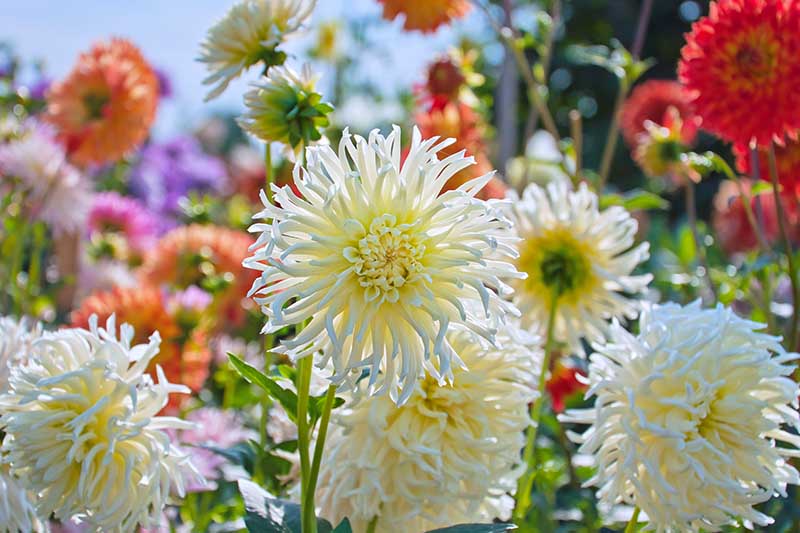
And although they require a little bit of extra care in lifting and storing tubers over winter, it’s well worth the effort for their long, showy season and vases full of gorgeous cut flowers.
How about you folks, how do you use dahlias in the garden? Let us know in the comment section below!
And for more information about growing dahlia flowers in your garden, check out these guides next:
